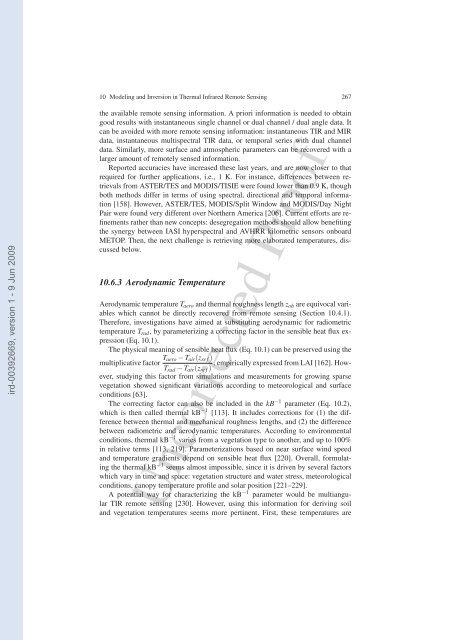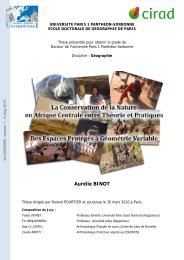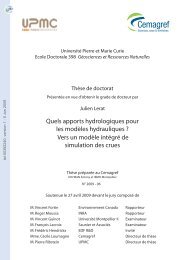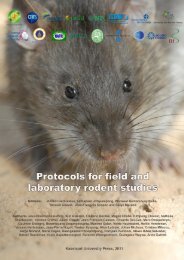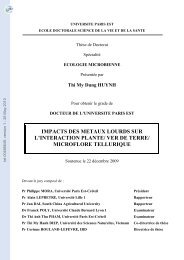Modeling and Inversion in Thermal Infrared Remote Sensing over ...
Modeling and Inversion in Thermal Infrared Remote Sensing over ...
Modeling and Inversion in Thermal Infrared Remote Sensing over ...
You also want an ePaper? Increase the reach of your titles
YUMPU automatically turns print PDFs into web optimized ePapers that Google loves.
10 <strong>Model<strong>in</strong>g</strong> <strong>and</strong> <strong>Inversion</strong> <strong>in</strong> <strong>Thermal</strong> <strong>Infrared</strong> <strong>Remote</strong> Sens<strong>in</strong>g 267ird-00392669, version 1 - 9 Jun 2009the available remote sens<strong>in</strong>g <strong>in</strong>formation. A priori <strong>in</strong>formation is needed to obta<strong>in</strong>good results with <strong>in</strong>stantaneous s<strong>in</strong>gle channel or dual channel / dual angle data. Itcan be avoided with more remote sens<strong>in</strong>g <strong>in</strong>formation: <strong>in</strong>stantaneous TIR <strong>and</strong> MIRdata, <strong>in</strong>stantaneous multispectral TIR data, or temporal series with dual channeldata. Similarly, more surface <strong>and</strong> atmospheric parameters can be rec<strong>over</strong>ed with alarger amount of remotely sensed <strong>in</strong>formation.Reported accuracies have <strong>in</strong>creased these last years, <strong>and</strong> are now closer to thatrequired for further applications, i.e., 1 K. For <strong>in</strong>stance, differences between retrievalsfrom ASTER/TES <strong>and</strong> MODIS/TISIE were found lower than 0.9 K, thoughboth methods differ <strong>in</strong> terms of us<strong>in</strong>g spectral, directional <strong>and</strong> temporal <strong>in</strong>formation[158]. However, ASTER/TES, MODIS/Split W<strong>in</strong>dow <strong>and</strong> MODIS/Day NightPair were found very different <strong>over</strong> Northern America [206]. Current efforts are ref<strong>in</strong>ementsrather than new concepts: desegregation methods should allow benefit<strong>in</strong>gthe synergy between IASI hyperspectral <strong>and</strong> AVHRR kilometric sensors onboardMETOP. Then, the next challenge is retriev<strong>in</strong>g more elaborated temperatures, discussedbelow.10.6.3 Aerodynamic TemperatureAerodynamic temperature T aero <strong>and</strong> thermal roughness length z oh are equivocal variableswhich cannot be directly rec<strong>over</strong>ed from remote sens<strong>in</strong>g (Section 10.4.1).Therefore, <strong>in</strong>vestigations have aimed at substitut<strong>in</strong>g aerodynamic for radiometrictemperature T rad , by parameteriz<strong>in</strong>g a correct<strong>in</strong>g factor <strong>in</strong> the sensible heat flux expression(Eq. 10.1).The physical mean<strong>in</strong>g of sensible heat flux (Eq. 10.1) can be preserved us<strong>in</strong>g themultiplicative factor T aero − T air (z re f ), empirically expressed from LAI [162]. However,study<strong>in</strong>g this factor from simulations <strong>and</strong> measurements for grow<strong>in</strong>g sparseT rad − T air (z re f )vegetation showed significant variations accord<strong>in</strong>g to meteorological <strong>and</strong> surfaceconditions [63].The correct<strong>in</strong>g factor can also be <strong>in</strong>cluded <strong>in</strong> the kB −1 parameter (Eq. 10.2),which is then called thermal kB −1 [113]. It <strong>in</strong>cludes corrections for (1) the differencebetween thermal <strong>and</strong> mechanical roughness lengths, <strong>and</strong> (2) the differencebetween radiometric <strong>and</strong> aerodynamic temperatures. Accord<strong>in</strong>g to environmentalconditions, thermal kB −1 varies from a vegetation type to another, <strong>and</strong> up to 100%<strong>in</strong> relative terms [113, 219]. Parameterizations based on near surface w<strong>in</strong>d speed<strong>and</strong> temperature gradients depend on sensible heat flux [220]. Overall, formulat<strong>in</strong>gthe thermal kB −1 seems almost impossible, s<strong>in</strong>ce it is driven by several factorswhich vary <strong>in</strong> time <strong>and</strong> space: vegetation structure <strong>and</strong> water stress, meteorologicalconditions, canopy temperature profile <strong>and</strong> solar position [221–229].A potential way for characteriz<strong>in</strong>g the kB −1 parameter would be multiangularTIR remote sens<strong>in</strong>g [230]. However, us<strong>in</strong>g this <strong>in</strong>formation for deriv<strong>in</strong>g soil<strong>and</strong> vegetation temperatures seems more pert<strong>in</strong>ent. First, these temperatures areUncorrected Proof


